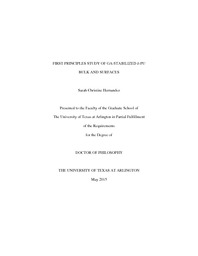| dc.contributor.author | Hernandez, Sarah Christine | en_US |
| dc.date.accessioned | 2015-07-31T22:09:58Z | |
| dc.date.available | 2015-07-31T22:09:58Z | |
| dc.date.submitted | January 2015 | en_US |
| dc.identifier.other | DISS-13016 | en_US |
| dc.identifier.uri | http://hdl.handle.net/10106/25000 | |
| dc.description.abstract | Plutonium (Pu) metal is highly reactive toward environmental gases and corrodes at a high rate. Due to this inevitable process, containers used to store Pu-based materials may experience catastrophic failure, subsequently releasing Pu particulates into the environment. Such interactions can be probed at the atomic scale using ab initio methods such as density functional theory (DFT). However, previous theoretical studies only examined these reactions with a pure δ-Pu surface. This is not realistic since δ-Pu exists at a high temperature (600K), therefore most technological applications of δ-Pu employ the alloyed form. The alloyed form is achieved with the addition of as little as 1 atomic percent (at. %) concentration of an alloying impurity such as elemental gallium (Ga) and aluminum (Al); this stabilizes δ-Pu from 600 K to 300 K. Thus, corrosion of δ-Pu may be affected by the alloying impurities and therefore realistic theoretical calculations must include such impurities. In this work, atomic oxygen and hydrogen adsorptions on the δ-Pu (111) surfaces with experimentally relevant Ga concentrations of 3.125 and 9.375 at. %. Ga concentrations were studied using DFT. The goals of the studies were to elucidate the role played by Ga in the reaction of δ-Pu surfaces with oxygen and hydrogen, particularly the geometric and electronic factors which dictate surface δ-Pu oxide and hydride formation. The results of the studies are summarized as follows: (i) Both hydrogen and oxygen preferred on-surface Pu-rich regions with three-fold coordination. (ii) Unfavorable chemisorption energies were realized when an adatom was coordinated with Ga or when it is adsorbed at interstitials sites. (iii) Electronic properties indicated that for both concentrations, Ga influenced the hybridization of the Pu 6d-O 2p states. However the degree of hybridization of the Pu 5f-O 2p states was dependent on the Ga concentration. (iv) Hydrogen slightly influenced the electronic properties. | en_US |
| dc.description.sponsorship | Huda, Muhammad N. | en_US |
| dc.language.iso | en | en_US |
| dc.publisher | Physics | en_US |
| dc.title | First Principles Study Of Ga-stabilized δ-Pu Bulk And Surfaces | en_US |
| dc.type | Ph.D. | en_US |
| dc.contributor.committeeChair | Huda, Muhammad N. | en_US |
| dc.degree.department | Physics | en_US |
| dc.degree.discipline | Physics | en_US |
| dc.degree.grantor | University of Texas at Arlington | en_US |
| dc.degree.level | doctoral | en_US |
| dc.degree.name | Ph.D. | en_US |

